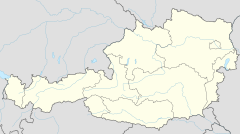KZ Mauthausen
| Mauthausen-Gusen | |
|---|---|
| Concentration camp | |

Gate to the garage yard in the Mauthausen concentration camp
|
|
| Other names | Mauthausen, Gusen |
| Location | in and around Mauthausen and Gusen, Upper Austria |
| Operated by |
DEST cartel and the Nazi Schutzstaffel (SS) Soviet Red Army (after World War II) |
| Commandant | Franz Ziereis |
| Operational | August 1938 – May 1945 |
| Number of inmates | mainly Soviet and Polish citizens |
| Killed | between 122,766 and 320,000 (estimated) |
| Liberated by | US Army, May 1945 |
Coordinates: 48°15′25″N 14°30′04″E / 48.25694°N 14.50111°E
Mauthausen-Gusen concentration camp was the hub of a large group of German concentration camps that was built around the villages of Mauthausen and Sankt Georgen an der Gusen (Gusen) in Upper Austria, roughly 20 kilometres (12 mi) east of the city of Linz. The camp operated from the time of the Anschluss, when Austria was annexed into the German Third Reich in early 1938, to the beginning of May 1945, at the end of the Second World War. Starting with a single camp at Mauthausen, the complex expanded over time and by the summer of 1940 Mauthausen had become one of the largest labour camp complexes in the German-controlled part of Europe, with four main subcamps at Mauthausen and nearby Gusen, and nearly 100 other subcamps located throughout Austria and southern Germany, directed from a central office at Mauthausen.
As at other Nazi concentration camps, the inmates at Mauthausen-Gusen were forced to work as slave labour, under conditions that caused many deaths. The subcamps of the Mauthausen complex included quarries, munitions factories, mines, arms factories and plants assembling Me 262 fighter aircraft. In January 1945, the camps contained roughly 85,000 inmates. The death toll remains unknown, although most sources place it between 122,766 and 320,000 for the entire complex.
...
Wikipedia

